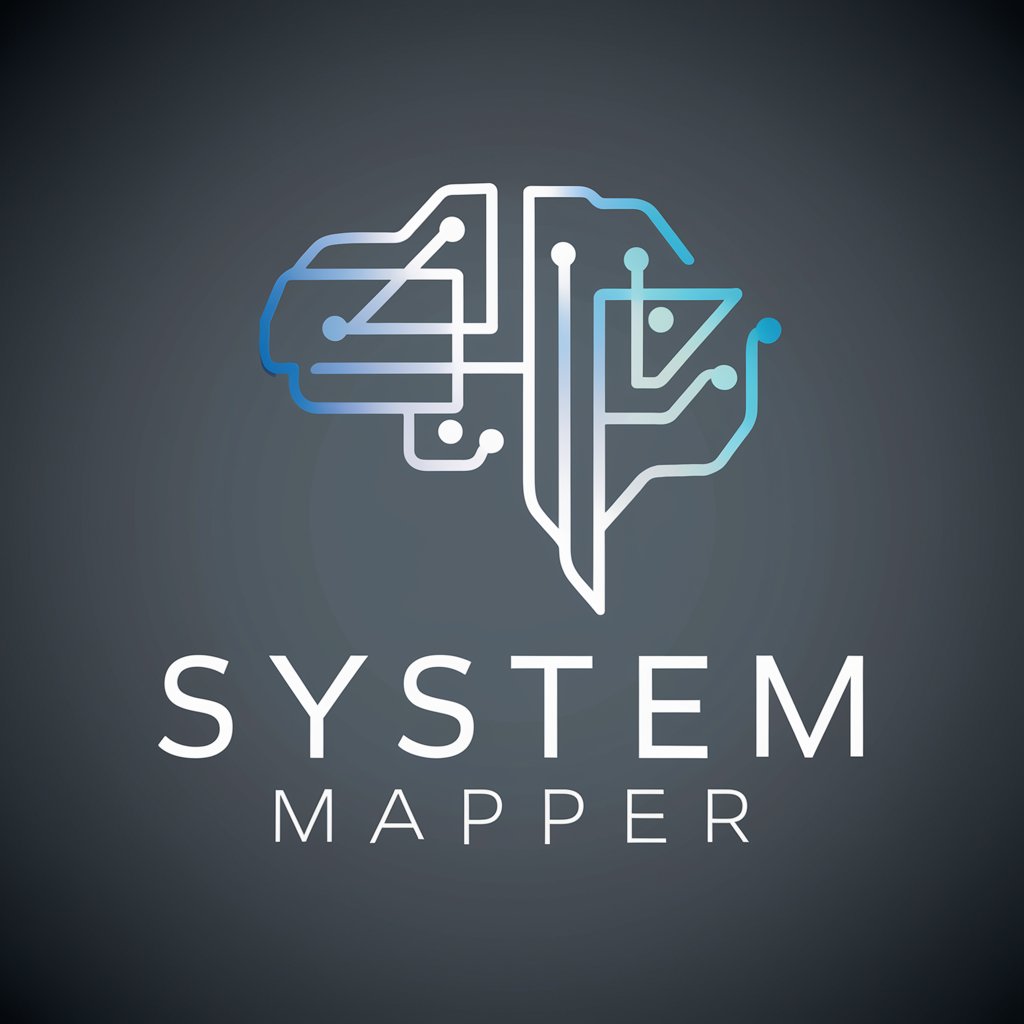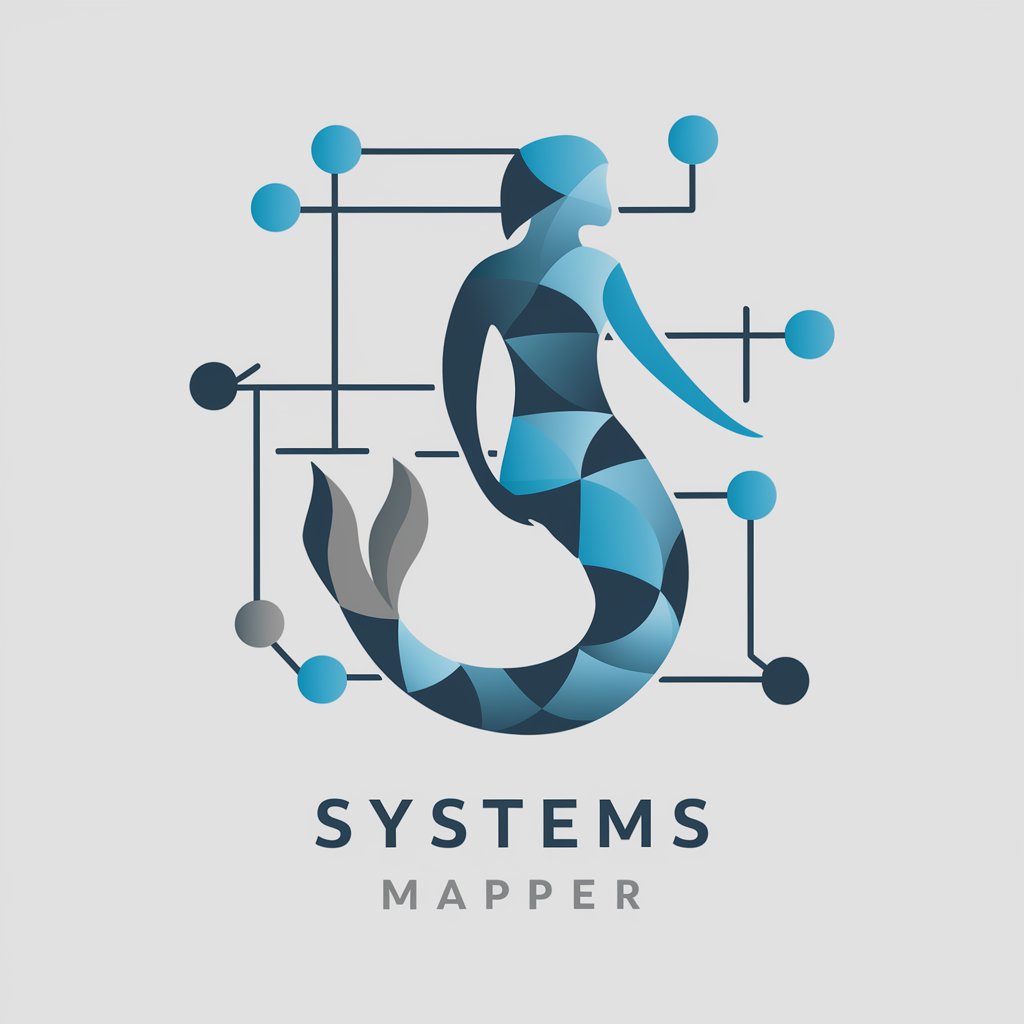
System Mapper - AI-powered System Visualization

Welcome! Let's start mapping your system.
Mapping complex systems, simplified.
Explain the process of identifying elements in a system map.
Describe how to define the purpose and scope of a system map.
How can relationships between system elements be mapped?
What are the key steps to visualize system dynamics effectively?
Get Embed Code
Understanding System Mapper
System Mapper is designed as a sophisticated tool aimed at simplifying the complex task of system mapping. By integrating principles of systems thinking and design research, it assists users in visualizing and understanding the intricate relationships and dynamics within any given system. The purpose of System Mapper is to aid in the creation of detailed system maps that reveal how various elements within a system interact, influence each other, and contribute to the system's overall behavior. An example scenario where System Mapper shines is in environmental policy development, where it can help stakeholders visualize the connections between economic activities, environmental impacts, and policy measures, thus facilitating a more informed decision-making process. Powered by ChatGPT-4o。

Core Functions of System Mapper
Defining Purpose and Scope
Example
Determining the focus of a system map for a community recycling program
Scenario
In this scenario, System Mapper guides users through identifying the specific problem or objective of the map, such as increasing recycling rates, and defines what elements (e.g., local government, community groups, waste management facilities) and relationships (e.g., policy influence, community engagement) to include, ensuring the map is targeted and effective.
Identifying System Elements
Example
Mapping the stakeholders in a public health initiative
Scenario
Here, System Mapper is used to identify all relevant parties involved in a public health initiative, including healthcare providers, patients, insurance companies, and regulatory bodies, highlighting how each contributes to the health system and the flows of information and resources between them.
Mapping Relationships and Dynamics
Example
Analyzing the impact of policy changes on educational outcomes
Scenario
In this application, System Mapper helps users explore how various factors such as teacher training, student socio-economic status, and new educational policies interact and influence each other over time, revealing potential feedback loops and leverage points for intervention.
Who Benefits from Using System Mapper?
Policy Makers and Government Officials
This group benefits from System Mapper's ability to clarify the complex interdependencies within policy ecosystems, helping to craft more effective and sustainable policies by visualizing the potential impacts and interactions of various policy options.
Researchers and Academics
Researchers in fields like social sciences, environmental studies, and public health use System Mapper to analyze and present complex systems in their studies, facilitating a deeper understanding of systemic issues and their potential solutions.
Business Leaders and Consultants
For those in the business sector, System Mapper aids in strategic planning and innovation management by mapping out the business ecosystem, including competitors, regulations, market trends, and internal processes, to identify opportunities and threats.

How to Use System Mapper
Start Free Trial
Visit yeschat.ai to begin using System Mapper without the need for a login or a ChatGPT Plus subscription.
Define Your System
Identify the system you wish to map. This could be an organizational structure, a process flow, or any complex system you're looking to understand or solve a problem within.
Gather Data
Collect all relevant data, including elements, relationships, and dynamics of your system. The more detailed your data, the more comprehensive your system map will be.
Map Your System
Use System Mapper's interface to input your data and visualize the system. Leverage the tool's features to highlight connections, influences, and feedback loops within your system.
Analyze and Iterate
Use the generated system map to analyze the system's structure and dynamics. Identify areas for improvement or further exploration and iterate on your map as needed.
Try other advanced and practical GPTs
Kubernetes Practice
Master Kubernetes with AI-powered simulations

PySCEMU Helper
Empowering emulation with AI assistance.

React Helper
Empowering React development with AI

Knowledge Navigator
Empower Your Learning with AI

E-commerce Product Description Generator
Crafting Unique, AI-Powered Product Narratives

Your GA4 Expert - Hack the Growth
Empower Your Analytics with AI

Destiny guides
Empower your choices with AI tarot insights.

KANG DONG HYUP
Empowering Your Decisions with AI

Avatar
Transform Photos into Avatars with AI

Cook GPT
Your AI-powered culinary companion

Interactive horror game
Unravel mysteries in AI-powered darkness.

Benefits Buddy
Empowering benefits decisions with AI

Frequently Asked Questions about System Mapper
What is System Mapper?
System Mapper is an AI-powered tool designed to help users visualize and understand complex systems. It facilitates the creation of detailed system maps that highlight elements, relationships, and dynamics.
Who can benefit from using System Mapper?
Researchers, educators, policy makers, business analysts, and anyone involved in managing or understanding complex systems can benefit from using System Mapper.
What makes System Mapper unique?
System Mapper's AI capabilities allow for a dynamic and interactive mapping experience, enabling users to visualize complex interdependencies and system dynamics in a way that's intuitive and insightful.
Can System Mapper be used for any type of system?
Yes, System Mapper is versatile and can be used to map a wide range of systems, from natural ecosystems to organizational structures, processes, and beyond.
How do I share my system maps with others?
System Mapper allows you to export your system maps in various formats or share them directly through integration with popular collaboration tools.





